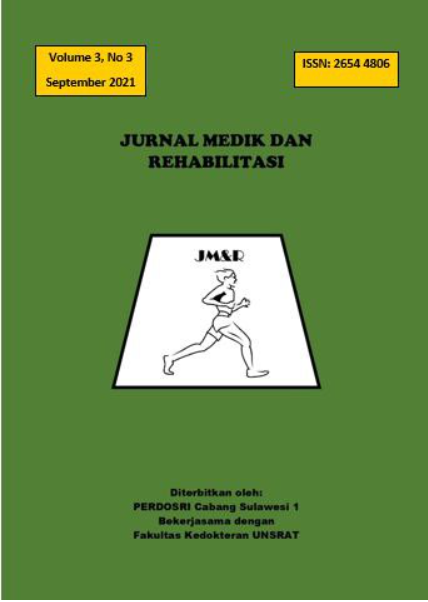MEDICAL REHABILITATION IN PATIENT WITH RIGHT HEMOPNEUMOTHORAX
Abstract
Hemothorax refers to a collection of blood within the pleural cavity. By deï¬nition this bloody pleural effusion should contain a haematocrit value of at least 50% of the haematocrit of peripheral blood.1Pneumothorax is defined as the collapse of lung due to presence of air between parietal and visceral pleural cavity.This air pushes on the outside of the lung and makes it collapse. In most cases, only a portion of the lung collapses. Patients commonly have pleuritic chest pain, dyspnea, tachypnea, and tachycardia. Breath sounds may be diminished and the affected hemi thorax hyper was resonant to percussion-mainly with larger pneumothorax. Pneumothorax may be described as simple pneumothorax or tension pneumothorax. It can also be classified as open, closed and occult pneumothorax.2,3
Hemopneumothorax is the presence of both blood and air in the pleural cavity and may be caused by blunt or penetrating trauma.Stab wounds are the main cause of penetrating injuries.4,5 Early detection and treatment of hemopneumothorax is of most importance in prognosis of the patient. About 60% of polytraumas are associated with thoracic trauma. 150,000 Americans die due to trauma every year and it is the most common cause of death in the population 50% of patients dying immediately and less than 10-15% surviving until hospital admittance with critical vital signs.6
The traumatic hemopneumothorax is a result of blunt or penetrating trauma. Numerous factors affect the respiratory response. A trauma associated respiratory failure may occur directly or indirectly. An indirectly associated respiratory failure occurs because of pulmonary infection, fibrothorax as a late complication and trauma in a patient with underlying disease. Needle aspiration as a definitive treatment of a hemopneumothorax is an obsolute intervention. The adequate approach to a hemopneumothorax is a complete evacuation of retained clots either by tube thoracotomy. A chest tube is commonly sufficient to accomplish this goal.6
References
Boersma W G, Stigt J A, Smith H J M.Treatment of Haemothorax. 2010
Zarogoulidis P, et al. Pneumothorax: from definition to diagnosis and treatment. Thorac Dis 2014;6(S4):S372-S376.
Metin B, et al. Comparison of different respiratory exercise methods in patients with chest tubes for spontaneous pneumothorax. Turk Gogus Kalp Dama 2016;24(4):717-721
Mahmut T, Mehmet E, Mustafa D, Muhammed S, Huseyin A. Approach to Pneumothorax in Emergency Department. Med J of Islamic World Academy of Sciences (Internet). 2015 (cited 2017 Feb 2); 23(3): 98-107. Available from : www.journalagent.com.pdf
© 2015 Trauma.Org. Haemothorax (Chest Trauma Haemothorax). Available at www.trauma.org download February 5, 2018.
Mahoozi H R, Volmerig J, Hecker E. Modern Management of Traumatic Hemothorax. Department of Thoracic Surgery, Evangelisches Krankenhaus, Herne, Germany. 2016
Halar E M, Bell K R. Phiysical Inactivity: Physiological and functional impairments and their treatment. In: De Lisa’s Physical Medicine and Rehabilitation. Principles and practice. 5thEd. P 1249-72
Bartels M, Prince D Z. Acute Medical Conditions. In: Braddom’s Physical Medicine and Rehabilitation. 5th Ed. Chapter 27. P 571-95
Nusdwinuringtyas N. Kumpulan Makalah Rehabilitasi Respirasi Ed II. Jakarta: Departemen Rehabilitasi Medik RSCM; 2012
Gonzalez P, MelilloN G, MacBruceD K, CuccurulloS J. Pulmonary, Cardiac Rehabilitation. In: Physical Medicine and Rehabilitation Board Review.3rd Ed. Edited by Sara J. Cuccurullo, MD. P668
Orfanosl P, Ellis E, Johnston C.Effects of deep breathing exercises and ambulation on pattern of ventilation in post-operative patients.IThe University a/Sydney, Westmead Hospital.
Incentive Spirometry. Available from: http://www.ceu.org/cecourses/981130/ch7.htm. [Cited: 23rd August 2017]
AARC Clinical Practice Guideline. Incentive Spirometry. Available from: www.rejournal.com. [Cited: 23rd August 2017]
How to use insentive spirometry. Available from: https://my.clevelandclinic.org/health/articles/how-to-use-an-incentive-spirometer. March 2017. [Cited: 23rd August 2017]
Insentive Spirometry Chart. Available from: http://emupdates.com/2009/11/25/incentive-spirometer/untitled/. [Cited 25th August 2017]
Guidelines for the six-minute walk test. American Thoracic Society. RespirCrit Care Med Vol 166. pp 111–117, 2002
Exercise Training in Pulmonary Rehabilitation. Available from: https://www.researchgate.net/publication/261565726_Exercise_Training_in_Pulmonary_Rehabilitation. [Cited: Sep 7, 2017]
Guidelines for the six-minute walk test. American Thoracic Society. RespirCrit Care Med Vol 166. pp 111–117, 2002
Tulaar ABM, Wahyuni LK, Wirawan RP, Aliwarga J. Layanan Kedokteran Fisik Dan Rehabilitasi. Perdosri; 2013.
General principles of exercise prescription. In: Thompson WR, Gordon NF, Pescatello LS, editors. ACSM’s Guidelines for Exercise Testing and Prescription. 8th Edition. Philadephia: Lippincott Williams & Wilkins; 2010: 152-155.
Dean, E: Mobilization and exercise. In Frownfelter, D, Dean, E (eds) Cardiovascular and Pulmonary Physical Therapy: Evidence and Practice, ed 4. Mosby, St. Louis, 2006, pp 263–306
Kisner Carolyn, Colby Lynn. Range of Motion. In: Therapeutic Exercise. 6th edition. 2012. Chapter 3. P51-71
Kalisch B J, Lee S, Dabney B W. Outcomes of inpatient mobilization: a literature review. 2013

